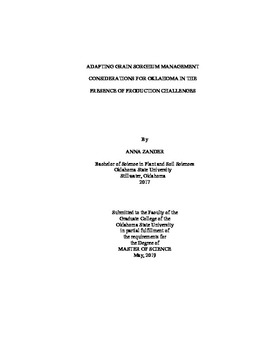| dc.contributor.advisor | Lofton, Josh J. | |
| dc.contributor.author | Zander, Anna | |
| dc.date.accessioned | 2019-10-25T20:25:27Z | |
| dc.date.available | 2019-10-25T20:25:27Z | |
| dc.date.issued | 2019-05-01 | |
| dc.identifier.uri | https://hdl.handle.net/11244/321625 | |
| dc.description.abstract | Grain sorghum (Sorghum bicolor (L.) Moench), is a crop commonly grown in Oklahoma and the southern Great Plains mainly because of its resilience and yield stability in the midst of drought conditions. However, due to the sugarcane aphid (Melanaphis sacchari; SCA) and low grain prices, ground allocated to grain sorghum production has been slowly shifting to the production of other crops. Two studies were conducted to evaluate various agronomic management practices to mitigate the production and price risks associated with growing grain sorghum in Oklahoma. The first study was designed to assess the effects that varying planting dates, applying and not applying insecticide, and planting susceptible and tolerant hybrids have on the yield of grain sorghum in the midst of SCA presence. Trials were conducted in 2016, 2017, and 2018 in Oklahoma. Results indicated that planting date had a significant impact on grain yield with the effects of hybrid selection and insecticide applications significantly benefiting yields when sorghum was planted later. Planting from mid-April through mid-May resulted in the highest yields. When sorghum was planted in early-June, yield was lost when no insecticide application was made and when a susceptible hybrid was planted. Planting in late-March resulted in lower yields four out of the five site-years, most likely due to low soil temperatures at planting. The second study was designed to evaluate the potential of utilizing grain sorghum residue left after harvest as forage for livestock in the time between the availability of high quality summer forages and high quality winter forages such as winter wheat. Trials were also conducted in 2016, 2017, and 2018 in Oklahoma. Adequate amounts of forage remained in the field after harvest ranging from 3829 kg ha-1 to 10129 kg ha-1. However, the quality of the residue was low and may require supplementation for certain grazing animals. Nitrate toxicity is a common issue found in grazing plants in the sorghum genus. Throughout the study NO3- concentrations ranged from 310 ppm to 3727 ppm, with the highest amounts being found in regions prone to environmental stresses. | |
| dc.format | application/pdf | |
| dc.language | en_US | |
| dc.rights | Copyright is held by the author who has granted the Oklahoma State University Library the non-exclusive right to share this material in its institutional repository. Contact Digital Library Services at lib-dls@okstate.edu or 405-744-9161 for the permission policy on the use, reproduction or distribution of this material. | |
| dc.title | Adapting Grain Sorghum Management Considerations for Oklahoma in the Presence of Production Challenges | |
| dc.contributor.committeeMember | Arnall, Daryl B. | |
| dc.contributor.committeeMember | Royer, Tom A. | |
| osu.filename | Zander_okstate_0664M_16198.pdf | |
| osu.accesstype | Open Access | |
| dc.type.genre | Thesis | |
| dc.type.material | Text | |
| thesis.degree.discipline | Plant and Soil Sciences | |
| thesis.degree.grantor | Oklahoma State University | |
